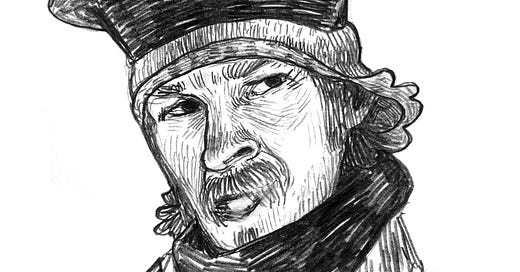Crafty Sailors: British Knits Onboard AMC's "The Terror"
This article was originally published on August 3, 2020.
Since March, time has felt like it is at a standstill. Like many, I remain in place, sheltering in my apartment and only venturing outside when it is time to buy groceries or the occasional used paperback. I have struggled to write a complete blog post since COVID-19 restrictions began. My notebook is overflowing with ideas and yet my fingers have gone still and my keyboard unloved. Luckily, it was only a few weeks ago that I decided to binge-watch the first season of AMC’s anthology horror series The Terror.
The Terror presented us with a survival narrative surprisingly fit for today as opposed to 2018, the year in which it aired. The show is an adaptation of the speculative fiction book of the same name by Dan Simmons and tells an imagined account of John Franklin’s lost 1845 expedition to the Arctic. The expedition, whose goal it was to discover the Northwest Passage for the British Empire, resulted in the disappearance of the ships HMS Erebus and HMS Terror as well as all of the souls onboard them. The resulting story is chilling and - although not entirely reassuring in the face of real-world evils - helps to put some (not all) current struggles into perspective. We, at least, do not face the perils of a dark and deathly winter, the threat of cannibalism, or the jaws of an unearthly bear!
Horrors real and fictional aside, the costumes in The Terror are linked to today’s fashions. This is largely because sailor-inspired fashion has experienced a powerful resurgence since the Fall runways of 2018. Whether nautical fashion has shown its face through the go-to indie skater boy wardrobe, the beanies of method actors Daniel Day Lewis and Robert Pattinson, or on the Chanel and Hermès runways, it has stubbornly forced its way back into contemporary fashion trends. (Although one could easily make the argument that it has persisted since the 19th century...) It is a happy coincidence, then, that The Terror premiered in the same time frame.
The costumes in The Terror are designed by period drama veteran Annie Symons. Symons, who has designed for other shows such as The Hollow Crown and Da Vinci’s Demons, incorporates close attention to detail and historical accuracy into every crew member’s wardrobe. Each outfit demonstrates the adjoining character’s rank, origin, and motivations. The treacherous caulker’s mate Cornelius Hickey, for instance, crafts his forged identity by sneakily acquiring items from crew members who have died. The Royal Navy Officer James Fitzjames, who comes from humble beginnings, wears an impeccably cared-for uniform that demonstrates unerring dedication to his station. See Symons’s website for some beautiful photo portraits of The Terror’s main players.
The details are what make the costumes in The Terror such a thrill to observe. Upon a close look, you may notice the wide variety of sailor’s knitwear seen over the course of the show’s ten episodes. It may be the craft craze born out of my self-isolation that got me excited when I saw sailors wearing all sorts of woolen knits, but that makes such things no less interesting as a wider topic. What exactly is that funny hood that the sailors wear under their caps? What is the name and purpose of the strange cap that Mr. Blanky wears onto the ice? Are these all things that the real members of the Franklin expedition would have worn? Put on your favorite chunky sweater and get ready because knitting is about to get historical - and a bit icy.
Wool has been a crucial element of seafarer’s wardrobes for centuries. This is in part due to its warmth and moisture-repelling lanolin fibers. Wool clothing, such as the sweaters and hats worn by the men of the Franklin expedition, is additionally important in the context of The Terror because wool is a notable product and export of the United Kingdom. It is a key artifact of Britain’s long history and, in the face of foreign cultures during the Victorian “Age of Expansion,” is strongly linked to national pride and quintessential Britishness. After watching The Terror, it is clear that there is more to dressing like a member of a British Navy expedition than putting on a fisherman’s cap or chunky sweater. Underneath the knitting, you must foster a driven and terrifying determination to survive at any cost! Or, in the case of the “good eggs,” be ready to do whatever is best for the entire crew - let no man be left behind and no Terror episode unwatched!
Within The Terror, there is a wide range of knit items such as different kinds of caps and hoods, gloves, and items such as socks and intimates. The most obvious and familiar is the sweater. The knit wool fisherman sweater, an iconic piece of a sailor’s wardrobe, did not become popular until the 1800s when its styles became standardized and it began to be sold commercially. British knitwear is especially interesting because of the regional differences in its styles. There are some hugely popular styles of fisherman sweater, for instance, and each is named for their place of origin: Shetland, Aran, and Gansey. There are many knit sweaters we see in The Terror but the best is that of Lieutenant Fitzjames. It is made out of a beautiful cream-colored wool and knit in the Gansey style. Such a sweater would be worn as just one of many layers meant to keep a man warm in the Arctic climate.


Another knit garment present on the HMS Erebus and HMS Terror is the Welsh wig. Welsh wigs are a type of knit headgear that was popular in the 19th century. The wig functions as a cap with a long tail of soft wool that helps keep the wearer’s neck warm. While not particularly colorful or dashing, the Welsh wig caught my eye on screen because of the peculiar scalloped, loose-knit detailing along its tail. Because of this feature, the Welsh wig resembles curly hair peeking out from under a cap. The practical purpose of this detail is a mystery to me so I assume that it is ornamental only. In The Terror, many characters are seen donning Welsh wigs before going on deck or into the snow. Keeping warm in the Arctic is all about layering!
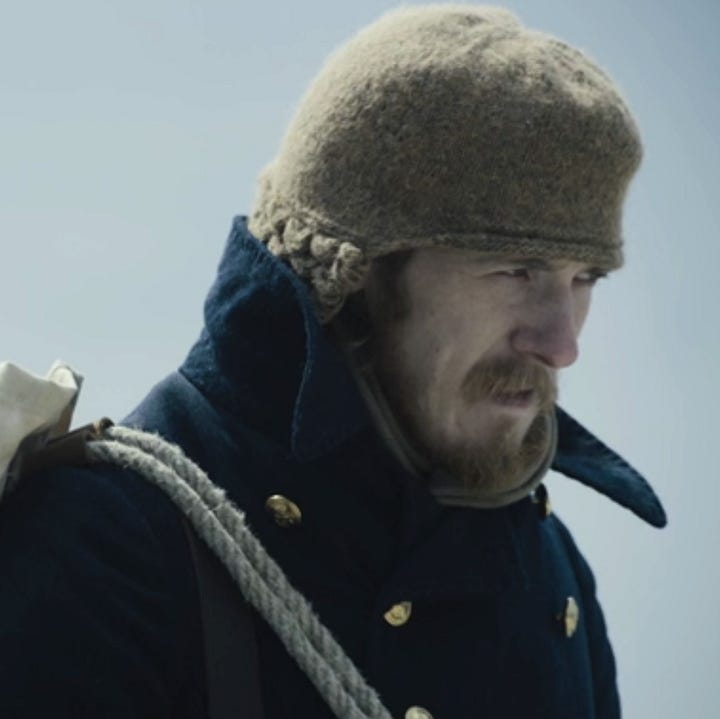
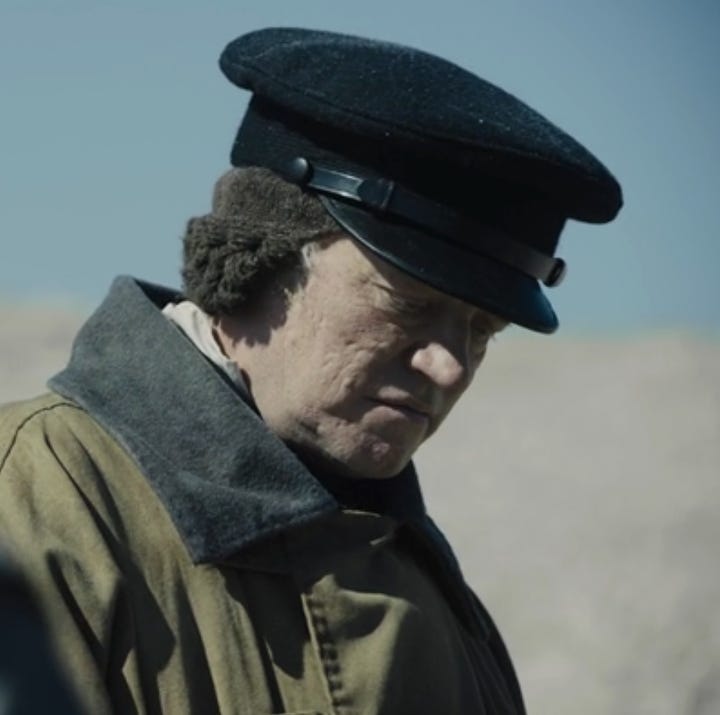
Similarly unique in appearance is the thrum cap. The thrum cap is a voluminous hat knit from raw wool that, to me, resembles a clover flower or even a Russian ushanka hat. The use of raw wool in a clothing item such as this would be because of the aforementioned lanolin fibres and their hydrophobic nature; they were worn by fishermen and sailors because they would keep the wearer both warm and dry. Thrum caps have a longer history than the fisherman sweater. Their popularity stretches all of the way back to the 16th century! The thrum cap’s appearance in The Terror is hard to miss. Ice master Thomas Blanky wears one along with a balaclava cap, for example.
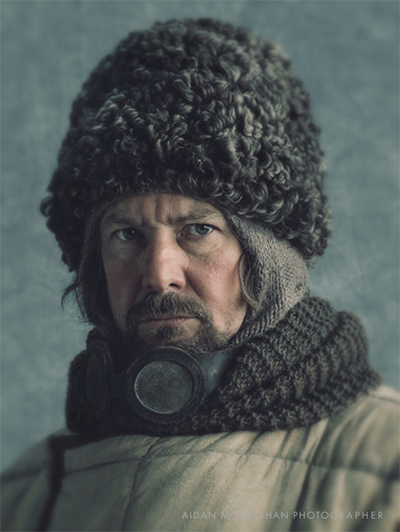
Scarves and gloves, although less unfamiliar and exciting objects than Welsh wigs and thrum hats, are as much of a staple on the Erebus and Terror as they are in our closets today. There are beautiful examples of detailed knit scarves aboard the ships, such as the sanquhar scarf worn by Lieutenant Irving. The sanquhar style, named after the town in Scotland, is intricate, beautiful, and made with double-sided knitting. To combat frostbite, gloves and mittens are crucial! Gloves used on 1840s Arctic expeditions could be knit, fingerless, used as one of many layers for warmth, and were a necessity for the cold Arctic weather. Some alternative glove materials were leather and fur, which allowed extra warmth and protection from the elements. No doubt the combination of wearing thick gloves and having to protect yourself with a pistol against a giant man-eating polar bear would be nerve-wracking, if not seemingly impossible!

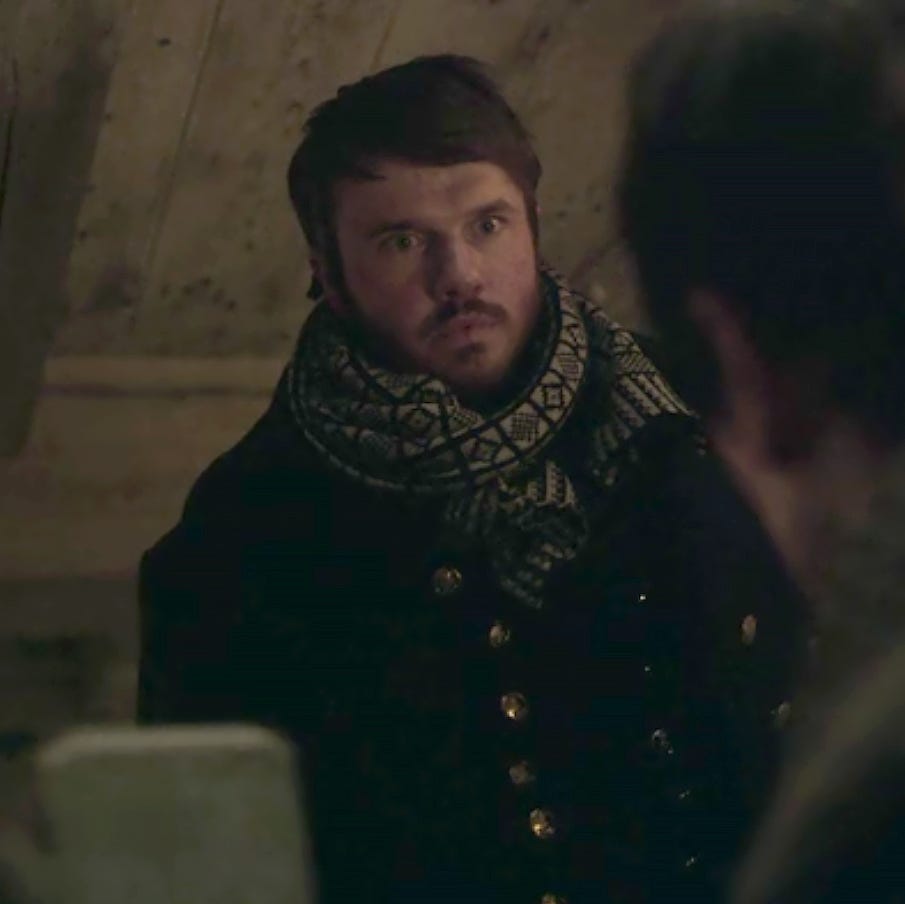
While historic knit garments are intriguing alone, the notion that each garment was made by hand in England adds another dimension of meaning onto them. Although a subtle connection, their handmade status forms a parallel between the knitwear worn by the crews of the Erebus and Terror and the determination in England to bring them home. This effort, spearheaded by Lady Jane Franklin herself (portrayed in the show by Greta Scacchi), demonstrates the investment of the British public in the British Naval expeditions and their crews. It is this idea that bookends the show’s events; its first and last scenes reference the rescue mission sent to retrieve Franklin’s men. While the 19th century British Empire itself may have seen the crew members as a dispensable means to global prestige and monetary gain, the people of England were dedicated to the explorers and their accomplishments - even their fashions - were greatly esteemed. With that consideration, the knit clothing worn in The Terror helps tie a thread between England itself and the souls and motivations of each man onboard.
There are numerous wardrobe pieces within this show’s first season that still deserve exploration, especially those belonging to Silna (played by Nive Nielsen), an Inuit shaman also known as Lady Silence. However, knitwear and the Royal Navy presented itself as an especially relevant topic in these days of crafting in seclusion. All in all, The Terror serves as great inspiration to pick up those knitting needles and get to work! If you’re interested in Terror-inspired knitting patterns, such as a pattern for recreating Officer Fitzjames’s Garney sweater, check out the historical knitting blog “The Secret Craftroom of HMS Erebus.” I, for one, know I will be sporting a fisherman’s cap and my own Fitzjames sweater once the temperature drops. Who knows, maybe I’ll take a risk and don a Welsh wig, too!
The Terror is streaming on Hulu. All character/costume designs and stills belong to AMC. Header illustration by Izzy Peterson.

